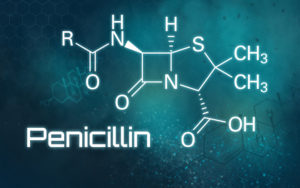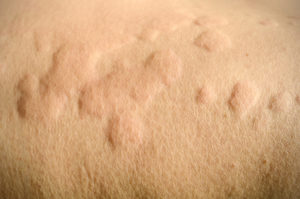Penicillin Allergy

Penicillin allergy is reported in roughly 7-10% of the general population and in up to 20% of hospitalized patients. Even though the reported numbers are fairly high, approximately 90% of these reported cases do not actually have a penicillin allergy. Individuals think they are allergic, but in most cases, the symptoms that they experience are either a non-allergic side effect or completely unrelated to penicillin. An allergy to penicillin, however, appears to be the most common medication allergy, along with other antibiotics.
Penicillin is comparatively inexpensive while being very efficacious. This make it both a common as well as a good choice for clinicians to use when an antibiotic is necessary. For those who have a true allergy to penicillin, the penicillin is seen as a foreign “invader” and one’s immune system mounts a defensive response in order to try to subdue the “invader.” When the immune system mounts a response, chemical mediators are released into the bloodstream in order to attack the intruder. As a result of these chemical mediators (e.g., histamine, leukotrienes), the individual may experience itching, hives, and/or swelling. In severe cases, an anaphylactic reaction may occur where individuals may develop wheezing, shortness of breath, rapid heartbeat, and/or drop in blood pressure.
Most people with a probable history of penicillin allergy are given alternative antibiotics in order to treat infections. In most cases, the replacement antibiotic will be more expensive than penicillin. It also may not be as effective as penicillin. In addition, the use of a replacement antibiotic can result in bacteria developing resistance to these alternative antibiotics, which will be a detriment to the community as a whole. In the field of allergy and immunology, is important to distinguish between a “false” allergy and a “true” allergy to penicillin and related antibiotics, so that the correct and appropriate antibiotic can be utilized. The evaluation of penicillin allergy requires the use of a standardized penicillin testing protocol. At Black & Kletz Allergy, our board certified allergists routinely perform this procedure in our office. Skin testing has been used for the diagnosis and management of penicillin allergy since the 1960’s. The procedure is commonly performed with minimal risk. Penicillin skin testing can be done safely in properly selected patients with suspected penicillin allergy.
The procedure for penicillin skin testing involves 3 steps:
- Skin prick testing with a small amount of diluted penicillin allergens, negative control solution, and positive control solution.
- If the prick tests are negative after 20 minutes, intradermal skin testing is performed where a very small quantity of the allergen, negative control solution, and positive control solution is injected into the superficial layers of the skin.
- If the intradermal skin test in in this second stage is also negative after 20 minutes, the patient will be given 250 mg. of amoxicillin by mouth (i.e., oral challenge) and will be closely monitored for 90 minutes.
If the patient tolerates all 3 stages without any untoward effects, the patient may receive penicillin if needed without an increased risk of an immediate allergic reaction than that of the general population. Penicillin testing should only be performed in a healthcare setting only by an allergist with the knowledge, training, and experience to select appropriate patients for this procedure, interpret the test results, and manage a systemic allergic reaction if it were to occur. This procedure can accurately identify the roughly 9 of 10 patients, who despite reporting a history of penicillin allergy, can receive penicillin safely. It should be noted that most individuals who say that they are allergic to penicillin because “they were told they had a reaction as a young child” turn out not to have a penicillin allergy when tested by a board certified allergist. It is however important to be tested and to not just assume you will be negative. All presumed “penicillin-allergic” individuals should continue to avoid penicillin until they are tested by an allergist.
The board certified allergists at Black & Kletz Allergy have been diagnosing and managing penicillin allergy, as well as other medication allergies for more than 50 years. We treat both pediatric and adult patients. Black & Kletz Allergy has offices in Washington, DC, McLean, VA (Tysons Corner, VA), and Manassas, VA. All 3 of our offices have on-site parking. For further convenience, our Washington, DC and McLean, VA offices are Metro accessible. Our McLean office location offers a complementary shuttle that runs between our office and the Spring Hill metro station on the silver line. For an appointment, please call our office or alternatively, you can click Request an Appointment and we will respond within 24 hours by the next business day. If you have a penicillin allergy or think you have a penicillin allergy, we are here to help you by testing you to see if you are allergic to penicillin. Black & Kletz Allergy is dedicated to providing the highest quality allergy care in a relaxed, caring, and professional environment.

 As we enter into the Winter months, a sensitivity to cold temperatures may trigger some allergic reactions in susceptible individuals. Below are some conditions where exposure to cold can cause clinical disease.
As we enter into the Winter months, a sensitivity to cold temperatures may trigger some allergic reactions in susceptible individuals. Below are some conditions where exposure to cold can cause clinical disease. As Winter approaches, many individuals may begin to complain of allergy symptoms that are similar, if not identical to, the classic
As Winter approaches, many individuals may begin to complain of allergy symptoms that are similar, if not identical to, the classic  The vocal cords are V-shaped tissue folds within our voice box (i.e., larynx). The gap between the arms of the V is the opening into our windpipe (i.e., trachea). These are dynamic structures and move with the contraction and relaxation of the muscles attached to them. Normally the vocal cords open when we inhale and exhale, allowing the air to get in and out of lungs. They close while we eat, blocking food from entering into the windpipe. The vocal cords become narrowed when we speak. It is the vibration of the vocal cords that generates voice.
The vocal cords are V-shaped tissue folds within our voice box (i.e., larynx). The gap between the arms of the V is the opening into our windpipe (i.e., trachea). These are dynamic structures and move with the contraction and relaxation of the muscles attached to them. Normally the vocal cords open when we inhale and exhale, allowing the air to get in and out of lungs. They close while we eat, blocking food from entering into the windpipe. The vocal cords become narrowed when we speak. It is the vibration of the vocal cords that generates voice. Thanksgiving Day is usually a time when people gather with family and friends in order to be with each other, watch football, and of course, eat! Unless you or a family member has a
Thanksgiving Day is usually a time when people gather with family and friends in order to be with each other, watch football, and of course, eat! Unless you or a family member has a  Eosinophils are types of white blood cells which are part of our normal immune system. They tend to be elevated in allergic disorders. Eosinophils also play an important role in protecting us from certain infections and infestations from parasitic organisms.
Eosinophils are types of white blood cells which are part of our normal immune system. They tend to be elevated in allergic disorders. Eosinophils also play an important role in protecting us from certain infections and infestations from parasitic organisms. Sinus infections are quite common. They can vary in severity from being a nuisance on one end of the spectrum to severe and debilitating on the other end. The sinuses referred to in “sinus infections” are actually called “paranasal” sinuses because they are “near the nose.” Paranasal sinuses are cavities in the cranial and facial bones (i.e, skull) near the nose which help in filtering and moisturizing inhaled air that is inhaled through the nose. They also lighten the weight of the skull and are involved with voice resonance. There are 4 pairs of sinuses named for the corresponding bone that they are situated upon:
Sinus infections are quite common. They can vary in severity from being a nuisance on one end of the spectrum to severe and debilitating on the other end. The sinuses referred to in “sinus infections” are actually called “paranasal” sinuses because they are “near the nose.” Paranasal sinuses are cavities in the cranial and facial bones (i.e, skull) near the nose which help in filtering and moisturizing inhaled air that is inhaled through the nose. They also lighten the weight of the skull and are involved with voice resonance. There are 4 pairs of sinuses named for the corresponding bone that they are situated upon: